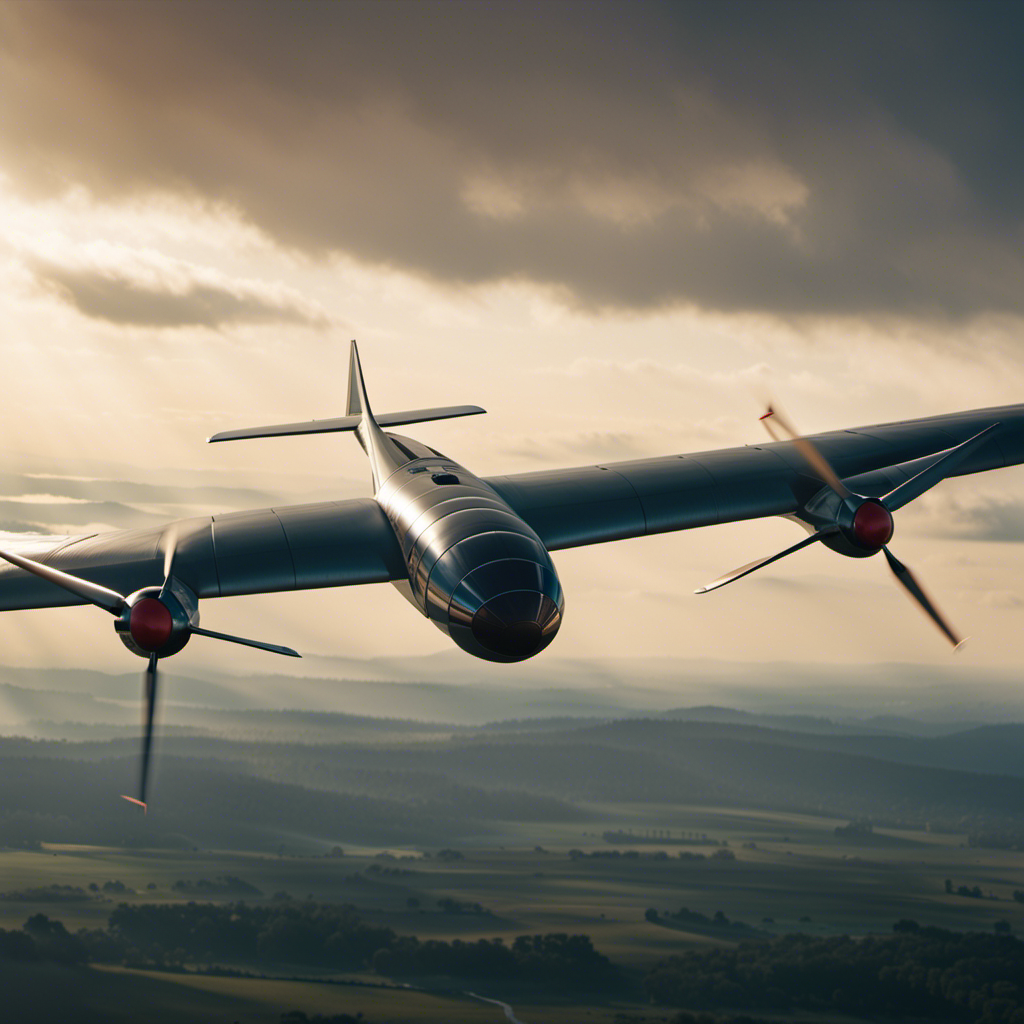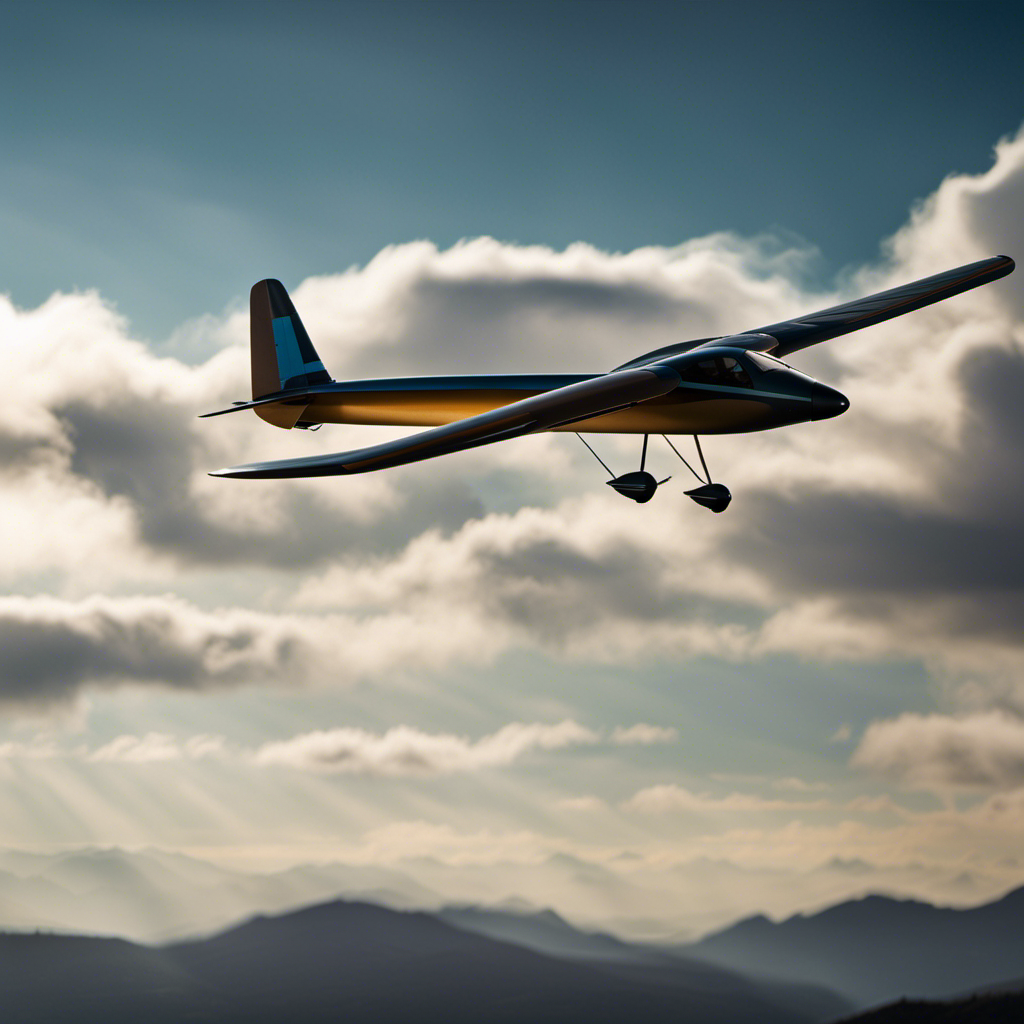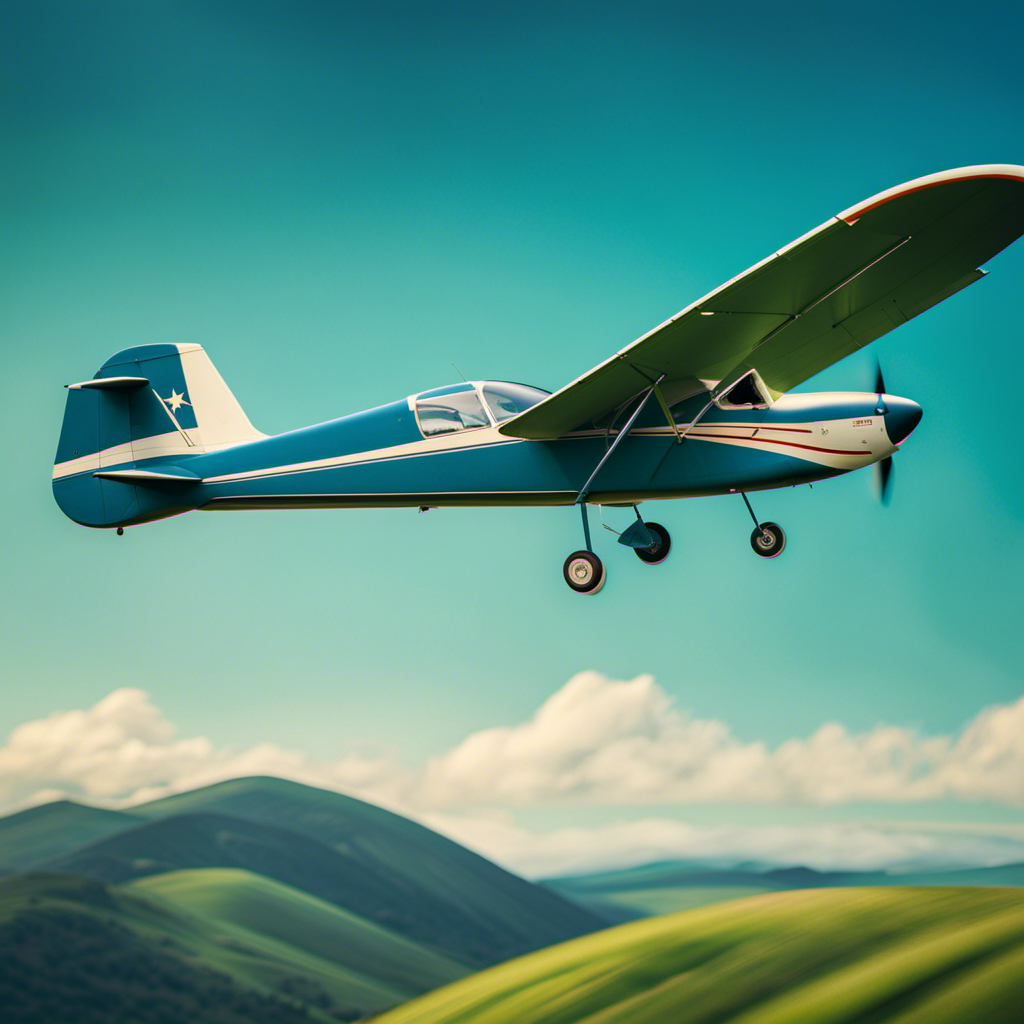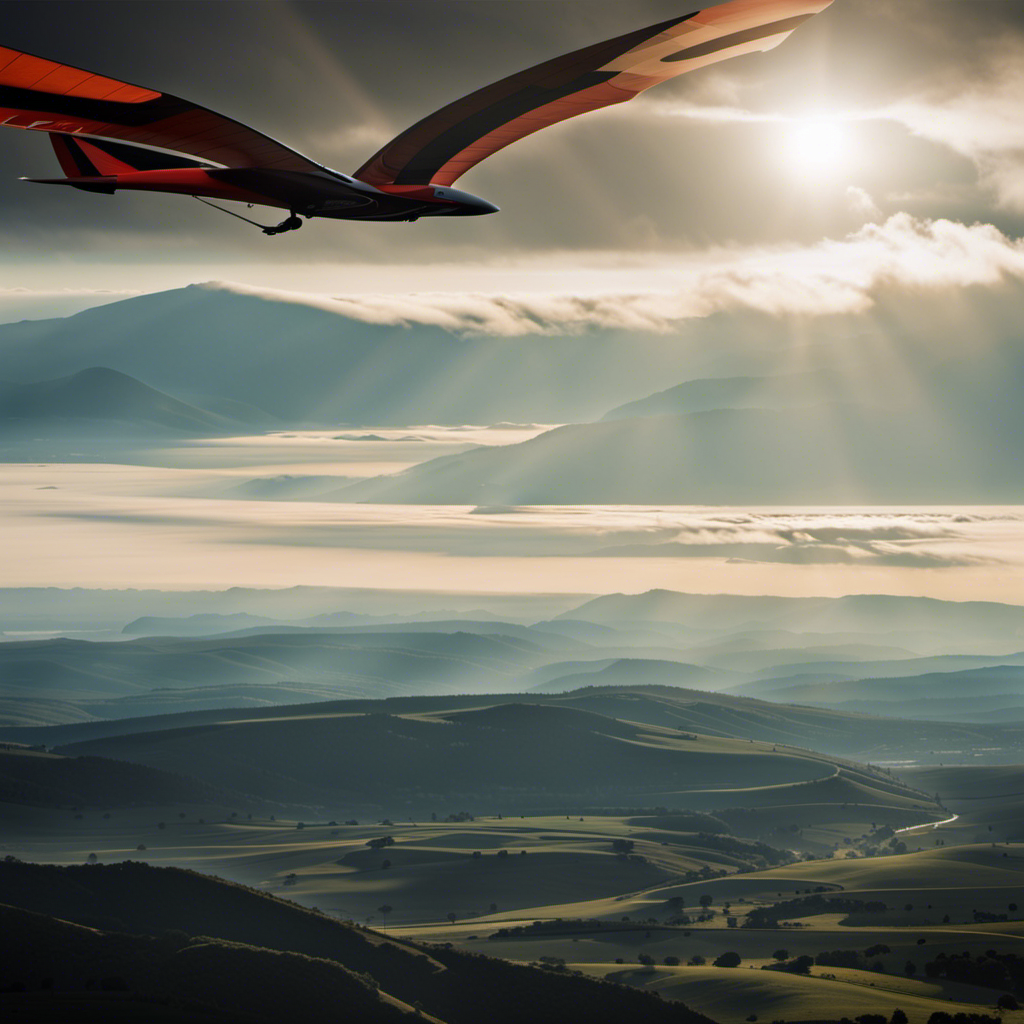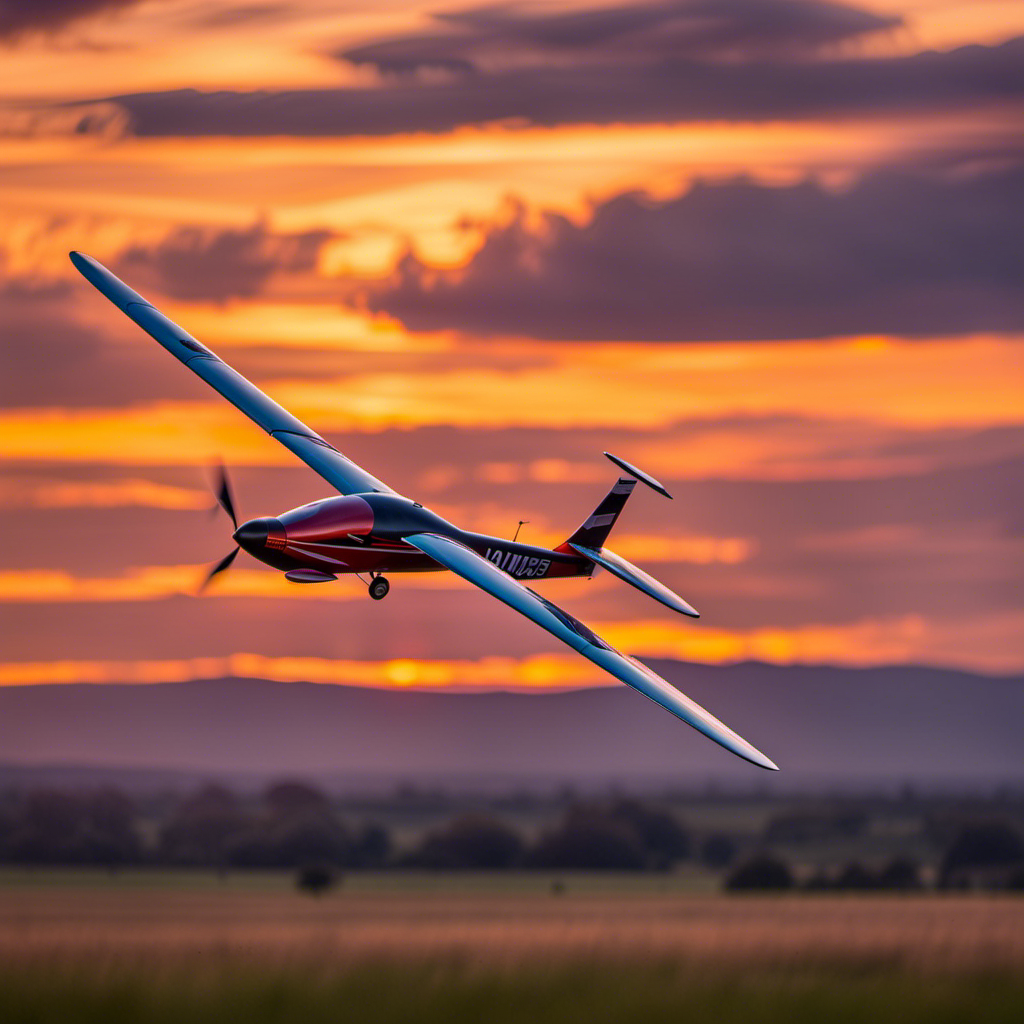Did you know that gliders can stay in the air for hours without using an engine? That’s right! Gliders rely solely on aerodynamics to stay afloat.
In this article, I will explain how a glider works, from its design to the techniques used for flying.
I will also discuss gliding safety, competitions, and the future of this exhilarating sport.
So buckle up and get ready to soar through the skies with me as we explore the fascinating world of gliders.
Key Takeaways
- Gliders are aircraft without engines that rely on aerodynamics for flight.
- Lift and drag are forces that act on the glider as it moves through the air.
- Gliders are designed to generate lift and allow unpowered flight.
- Launching methods for gliders include tow launch, winch launch, and aerotow.
What is a Glider?
A glider is a type of aircraft that doesn’t have an engine, allowing you to soar through the air using only the forces of nature. Gliders are designed with specific construction techniques to maximize their performance.
They are typically built with lightweight materials such as carbon fiber or fiberglass to reduce weight and increase maneuverability. The wings of a glider are designed with a specific shape and length to generate lift, while the fuselage is streamlined to minimize drag. These design considerations allow gliders to achieve impressive performance, such as long flight durations and high speeds.
Understanding the principles of aerodynamics, which govern the behavior of air around the glider’s wings and body, is crucial for maximizing performance and achieving efficient flight.
The Principles of Aerodynamics
When it comes to the principles of aerodynamics, there are three key points that play a crucial role: lift and drag, weight and gravity, and thrust and propulsion.
Lift and drag refer to the forces that act on an aircraft as it moves through the air. Lift is the upward force that opposes gravity, and drag is the resistance that opposes the aircraft’s forward motion.
Weight and gravity determine the downward force exerted on the aircraft.
Thrust and propulsion are responsible for propelling the aircraft forward.
Understanding these principles is essential for comprehending the mechanics behind flight and how aircraft are able to stay aloft.
Lift and Drag
To generate lift and reduce drag, you need to angle the wings of the glider correctly.
Lift mechanics is the force that allows the glider to stay airborne. It is created by the interaction between the shape of the wings and the flow of air around them. By tilting the wings upward, called angle of attack, the glider can generate more lift. However, a higher angle of attack also increases drag, which is the resistance force that opposes the motion of the glider through the air.
To minimize drag, the wings are designed to be streamlined and smooth. This reduces the air resistance and allows the glider to glide through the air more efficiently.
Now, let’s move on to the next section where we will explore the influence of weight and gravity on a glider’s flight.
Weight and Gravity
You can feel the effect of weight and gravity on your glider as it pulls downward, opposing the lift force. Weight distribution plays a crucial role in maintaining balance and stability during flight.
The glider’s weight is distributed between its wings and fuselage, with the majority of the weight concentrated in the fuselage. This distribution ensures that the center of gravity is positioned correctly, allowing the glider to maintain its desired attitude.
Gravity, on the other hand, exerts a force on the glider, pulling it towards the Earth. This force must be counteracted by the lift force generated by the wings to keep the glider airborne.
Understanding the effects of weight and gravity is essential in designing and operating a glider effectively.
Now, let’s transition into the next section where we explore the concept of thrust and propulsion.
Thrust and Propulsion
Understanding how thrust and propulsion work is crucial for achieving forward motion in your glider. To evoke an emotional response from the audience, consider these three important aspects:
-
Thrust generation: The key to generating thrust lies in the propulsion method used. Whether it’s a jet engine, propeller, or even a simple rubber band, the manner in which thrust is created can greatly impact the performance of your glider.
-
Propulsion methods: There are various ways to propel a glider forward. Some common methods include using a motor or engine, utilizing the force of wind or air currents, or even relying on gravity to gain momentum. Each method has its own advantages and limitations, so understanding them is essential for optimizing your glider’s performance.
-
Efficiency and control: Achieving the right balance of thrust and propulsion is crucial for efficient and controlled flight. By fine-tuning these factors, you can optimize your glider’s speed, maneuverability, and overall performance.
Now that we understand the principles behind thrust and propulsion, let’s delve into the design of a glider and how it influences its flight characteristics.
The Design of a Glider
The design of a glider is specifically engineered to generate lift and allow for unpowered flight. Engineers have developed efficient gliders capable of long flights by understanding the principles of aerodynamics.
The key components of a glider’s design include the wings, fuselage, tail, and control surfaces. The wings are designed with a specific airfoil shape to generate lift as the glider moves through the air. The fuselage provides structural support and houses the pilot and any additional equipment. The tail helps with stability and control, while the control surfaces, such as the ailerons and elevator, allow the pilot to maneuver the glider. Together, these elements work harmoniously to create a glider that can glide through the air effortlessly.
Transitioning into the subsequent section, launching a glider requires careful preparation and technique.
Launching a Glider
When it comes to launching a glider, there are several methods that can be used, each with their own advantages and considerations.
The first method is the tow launch, where the glider is attached to a powered aircraft by a tow rope and pulled into the air.
Another method is the winch launch, where a winch is used to rapidly reel in a cable attached to the glider, providing the necessary speed for takeoff.
Lastly, there is the aero-tow launch, which involves the glider being towed into the air by a powered aircraft, similar to the tow launch method, but with the difference being that the glider is attached to the aircraft with a tow bar instead of a tow rope.
Tow Launch
During a tow launch, a glider is pulled into the air by a powered aircraft. This method of launching a glider involves attaching a towline to the glider’s nose or a designated tow point.
Here are four key aspects of a tow launch:
-
Takeoff: Once the towline is secured, the powered aircraft accelerates down the runway, gradually building up speed. The glider, with its wings generating lift, follows closely behind.
-
Climb: As the powered aircraft gains altitude, it tows the glider upward. The glider’s pilot maintains a steady position in relation to the tow aircraft, using control inputs to maintain a safe and stable flight.
-
Release: Once the desired altitude is reached, the glider pilot signals the tow pilot to release the towline. The glider is now free to explore the skies using its inherent lift-producing properties.
-
Landing: After the towline is released, the glider pilot determines the appropriate time and place to initiate the landing, gliding smoothly back to the ground.
Transitioning into the subsequent section about ‘winch launch,’ a different method of launching a glider involves using a winch to rapidly unwind a cable, propelling the glider into the air.
Winch Launch
To launch a glider using a winch, you attach a cable to the glider’s nose or a designated tow point and rapidly unwind the cable to propel the glider into the air. This method of launching requires careful maintenance of both the glider and the winch to ensure safety and optimal performance.
Glider maintenance involves regular inspections of the aircraft’s structure, control surfaces, and systems, as well as proper cleaning and lubrication. Winch safety is also crucial and includes checking the winch’s cables, drum, and brakes for any signs of wear or damage. Additionally, winch operators must be trained and experienced in operating the winch and handling emergency situations effectively.
With proper glider maintenance and winch safety measures in place, a winch launch can provide a thrilling and efficient way to get a glider airborne.
Moving on to the next method of launch, the aero-tow launch, involves…
Aero-tow Launch
For an aero-tow launch, you’ll need a powered aircraft to tow your glider into the air. This method of launching a glider involves connecting a towline between the powered aircraft and the glider. Once the towline is connected, the powered aircraft accelerates down the runway, gradually increasing the speed until the glider lifts off from the ground. The glider relies on the power of the towing aircraft to gain altitude and speed.
Aero-tow launches offer several advantages over other launching methods. Firstly, they allow for greater flexibility in terms of launch location and direction. Additionally, they provide the glider with a higher initial altitude, which can greatly improve glider performance.
Transitioning from the aero-tow launch, let’s now discuss the various flying techniques that glider pilots employ to maximize their flight time.
Flying Techniques
Soaring, thermaling, and ridge soaring are three essential flying techniques used by glider pilots to stay aloft and maximize their flight time.
Soaring involves utilizing rising air currents, such as thermal updrafts or wind blowing up against a slope, to gain altitude and extend the flight.
Thermaling is a technique where pilots circle within a thermal column, a rising pocket of warm air, to gain height and then use the energy to continue the flight.
Ridge soaring, on the other hand, involves flying along the edge of a ridge or mountain where the wind is forced up and creates lift, allowing the glider to fly for longer durations.
Soaring
You can achieve soaring in a glider by finding pockets of rising air called thermals. Soaring techniques are essential for maximizing glider performance and staying aloft for longer periods. By understanding the behavior of thermals, glider pilots can exploit these updrafts to gain altitude and extend their flight time.
To illustrate the importance of soaring techniques, I have prepared a table that showcases the effect on glider performance when utilizing various techniques:
| Technique | Effect on Glider Performance |
|---|---|
| Finding thermals | Increased altitude gain |
| Riding ridge lift | Sustained forward progress |
| Utilizing wave lift | Extended distance covered |
| Centering thermals | Maximum climb rate achieved |
| Energy management | Efficient use of potential energy |
As you can see, employing these techniques can significantly enhance the performance of a glider and allow for extended flights. Now, let’s delve into the intricacies of thermaling, a fundamental aspect of soaring, without explicitly stating ‘step.’
Thermaling
After gliding through the currents in the previous section, we now delve into the fascinating world of thermaling. Thermaling is a technique used by glider pilots to gain altitude by exploiting thermal dynamics. These thermals are columns of rising air caused by the heating of the Earth’s surface.
Here are some advantages of thermaling:
- Efficient climb rate: Thermals can provide vertical speeds of up to 5 meters per second, allowing gliders to rapidly gain altitude.
- Extended flight time: By utilizing thermals, pilots can stay airborne for longer periods, maximizing their flying experience.
- Increased distance coverage: With the ability to climb higher, gliders can cover greater ground, expanding their exploration range.
- Enhanced safety: Thermals act as natural safety nets, providing pilots with opportunities to regain altitude and avoid potential hazards.
With the knowledge of thermaling, we can now seamlessly transition into the next section on ridge soaring, where pilots exploit another natural phenomenon to keep their gliders aloft.
Ridge Soaring
By using the uplift created by the wind hitting the ridge, pilots can effortlessly gain altitude and extend their flight time when ridge soaring.
Ridge soaring is a technique used by glider pilots to take advantage of the wind blowing against a ridge or a mountain slope. The air flowing up the slope generates an upward force known as ridge lift. This lift allows the glider to maintain or even increase its altitude without the need for an engine.
The performance of the glider in ridge soaring depends on various factors such as the shape and angle of the ridge, wind speed and direction, and the pilot’s skill in maneuvering the glider. Understanding these variables and making precise adjustments to the glider’s flight path is crucial in maximizing the time and distance covered while ridge soaring.
Transitioning into the subsequent section about glider instruments and controls, it is important for pilots to have a thorough understanding of these instruments and controls in order to effectively navigate and maintain control of the glider during ridge soaring.
Glider Instruments and Controls
The glider’s instruments and controls help me, as the pilot, navigate and maneuver through the air. These crucial tools allow me to understand and manipulate the glider’s flight dynamics.
Here are some of the key instruments and controls that aid me in glider navigation:
-
Airspeed Indicator: This displays the glider’s current airspeed, essential for maintaining safe and efficient flight.
-
Variometer: This instrument shows the rate of climb or descent, helping me find areas of rising or sinking air.
-
Altimeter: It provides me with the glider’s altitude above sea level, crucial for maintaining safe separation from other aircraft.
-
Rudder Pedals: These control the glider’s yaw, allowing me to maintain coordinated flight and make precise turns.
-
Ailerons: These control the glider’s roll, enabling me to bank the glider and initiate turns.
Understanding and utilizing these instruments and controls is vital for successful glider navigation.
Transitioning into the next section on gliding safety, these tools play a crucial role in ensuring a safe and enjoyable flight experience.
Gliding Safety
Before taking a glider up into the air, it is crucial to conduct thorough pre-flight checks to ensure the aircraft is in proper working condition. These checks involve examining the glider’s instruments, controls, and structural integrity.
Additionally, being prepared for emergency situations and knowing the correct procedures to follow is essential for a safe gliding experience. This includes understanding how to handle emergencies such as loss of altitude, control problems, or other unforeseen circumstances.
Lastly, weather considerations play a significant role in gliding safety, as understanding and assessing weather conditions is crucial for determining if it is safe to fly and making informed decisions during the flight.
Pre-flight Checks
First off, let’s make sure all the necessary pre-flight checks have been completed. Before taking to the skies, it is crucial to conduct a thorough pre-flight inspection to ensure the safety and functionality of the glider. This involves checking various components and systems, including the airframe, control surfaces, landing gear, and instruments.
Maintenance tasks, such as inspecting for any signs of wear or damage, lubricating moving parts, and verifying the integrity of the control cables, must also be carried out regularly. By following a strict pre-flight checklist, we can minimize the risk of mechanical failures or malfunctions during flight.
Now that we have confirmed the glider’s airworthiness, let’s move on to understanding the emergency procedures.
Emergency Procedures
Now that you’ve completed the necessary pre-flight checks, it’s important to familiarize yourself with the emergency procedures.
In the event of an emergency landing, the first step is to remain calm and assess the situation. If the glider is uncontrollable, the pilot must initiate the parachute deployment. To do this, pull the parachute handle located within easy reach. As the parachute deploys, it will slow down the descent and provide a controlled landing. It’s crucial to follow the correct procedures for parachute deployment to ensure a safe landing.
Once the parachute is deployed, the pilot must prepare for impact by assuming the proper brace position. This will minimize the risk of injury upon landing.
Transitioning into weather considerations, it’s important to evaluate the current and forecasted weather conditions before embarking on a glider flight.
Weather Considerations
Evaluating the current and forecasted weather conditions is essential before embarking on a glider flight. As a glider pilot, I must carefully analyze the weather conditions to ensure a safe and successful flight.
First, I examine the wind patterns, which play a crucial role in glider flying. I look for strong and consistent winds that can provide lift and help me stay aloft for longer periods.
Additionally, I consider the stability of the atmosphere, looking for signs of turbulence or convective activity that could make the flight challenging.
I also take into account the visibility, cloud cover, and precipitation, as they can affect visibility and thermals.
By thoroughly assessing these weather conditions, I can make informed decisions and plan my flight accordingly.
Now, let’s move on to the thrilling world of gliding competitions and records.
Gliding Competitions and Records
To understand how gliding competitions and records work, you should know that pilots compete to cover the longest distance or stay aloft for the longest time. Achieving these goals requires a combination of skillful gliding techniques and meticulous glider maintenance.
Pilots must master the art of maximizing lift through techniques such as thermaling, ridge soaring, and wave riding. These methods enable them to harness the natural sources of lift in the atmosphere and extend their flight time.
Additionally, proper glider maintenance is crucial to ensure optimal performance and safety. Regular inspections, repairs, and adjustments are necessary to keep the glider in top condition.
By continuously refining their techniques and maintaining their gliders, pilots can push the boundaries of gliding and set new records.
Looking ahead, the future of gliding holds exciting possibilities for advancements in technology and aerodynamics. Without a doubt, gliding will continue to captivate aviation enthusiasts and push the boundaries of human achievement.
The Future of Gliding
If you want to stay ahead in the world of gliding, you should keep an eye on the advancements in technology and aerodynamics.
The future of gliding holds exciting possibilities with the development of innovative technologies and sustainability measures.
Future technology in gliding includes advancements in materials and design, such as the use of carbon fiber composites for stronger and lighter glider structures.
Sustainable measures are also being explored, such as electric propulsion systems and improved energy efficiency.
These advancements aim to reduce the environmental impact of gliding and make it more accessible and affordable.
By staying informed about these developments, gliders can adapt and embrace the future of the sport.
Now, let’s delve into how to get started in gliding without delay.
Getting Started in Gliding
First things first, you’ll need to find a certified gliding instructor to guide you through the process of getting started in this exhilarating sport.
Learning the techniques of gliding requires a combination of theoretical knowledge and practical experience. Your instructor will teach you the principles of aerodynamics, including the forces acting on the glider and how to manipulate them for controlled flight.
You’ll also learn about the different types of gliders and their components, such as the wings, control surfaces, and the cockpit. During your training, you’ll practice launching the glider, maintaining altitude, and executing various maneuvers.
The instructor will provide feedback and guidance to help you improve your skills. With dedication and practice, you’ll soon become proficient in the art of gliding.
Frequently Asked Questions
What are some common challenges faced by glider pilots during flight?
Some common challenges faced by glider pilots during flight include navigating through turbulent weather conditions, finding thermals for lift, managing energy and speed, and making accurate landings in varying wind conditions.
How long can a glider stay in the air without any power source?
The longest flight duration of a glider without any power source is determined by various factors affecting glider flight time, such as weather conditions, altitude, lift sources, and pilot skill.
What are the different types of gliders and their specific uses?
There are various types of gliders, each with its specific use. For example, there are aerobatic gliders for thrilling maneuvers, and soaring gliders for long-distance flights. The advantages of glider flying include the freedom of silent, engineless flight.
Are there any specific regulations or licenses required to fly a glider?
To fly a glider, you must comply with specific regulations and obtain the necessary licenses. These requirements ensure safety and proficiency in operating a glider.
Can gliders be used for commercial purposes, such as passenger transportation or aerial photography?
Yes, gliders can be used for commercial purposes like passenger transportation and aerial photography. However, their economic feasibility depends on factors such as operating costs, demand, and competition in the market.
Conclusion
In conclusion, gliding is an exhilarating sport that combines the principles of aerodynamics with skillful flying techniques. The design of a glider allows it to take advantage of air currents and stay aloft for extended periods of time.
Launching a glider requires precise coordination and control, while flying techniques involve adjusting the glider’s position and speed to maximize efficiency. Safety is paramount in gliding, with strict protocols and procedures in place.
Gliding competitions and records push the boundaries of human achievement, and the future of gliding holds exciting possibilities. To get started in gliding, one must embark on a journey of learning and practice, but the rewards are unparalleled.
Soar through the skies, harnessing the power of the wind, and experience the freedom and beauty of gliding.
With a heart that soars as high as the skies, Aria, affectionately known as “Skylark,” is the driving force behind Soaring Skyways. Her journey into the gliding world began as a young dreamer gazing up at the soaring birds, yearning to experience the weightlessness and freedom they embodied. With years of experience both in the cockpit and behind the scenes, Aria’s commitment to the gliding community is unwavering.
